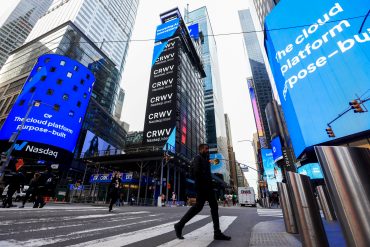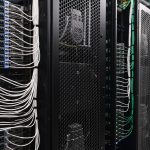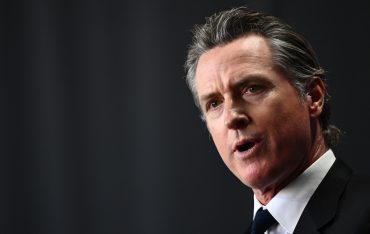
- AI Infrastructure
- Cloud & Infra
- Data Centers
The Architecture of Scale: CoreWeave’s $39 Billion in AI Commitments
5 minute read

CoreWeave secures $39 billion in long-term AI infrastructure deals with OpenAI, Meta, and Nvidia—signaling a structural realignment in global compute power.
Key Takeaways
- CoreWeave has secured $38.9 billion in AI infrastructure contracts, including an $18.4 billion pact with OpenAI, a $14.2 billion arrangement with Meta running to 2031, and a $6.3 billion order from Nvidia, delivering multi-year demand (averaging 5-7 years).
- The stock has climbed more than 200% since the March 2025 IPO, which raised $1.5 billion in the biggest US technology flotation since 2021, reflecting keen investor interest in specialised AI cloud providers.
- Chief executive Michael Intrator counters “circular investment” fears in AI, maintaining that blue-chip clients are buying capacity to satisfy real end-user needs rather than propping up an artificial ecosystem.
Introduction
AI infrastructure provider CoreWeave has locked in nearly $39 billion in multi-year contracts with leading technology companies, cementing its position as a critical player in the cloud services buildout extending into the early 2030s. Recent disclosures covering extensions with OpenAI alongside new agreements with Meta and Nvidia grant the company unusual revenue visibility in an industry known for sudden shifts. Against this backdrop, CoreWeave’s chief executive, Michael Intrator, addressed mounting Wall Street concerns about overlapping financing and dealmaking in the AI sector, calling the criticism “fundamentally flawed.”
With hyperscalers racing to build GPU-intensive data centres, CoreWeave’s tailored “neocloud” offering positions it as an essential provider—yet questions persist about the sustainability of AI spending levels. The company’s trajectory reflects broader tensions: explosive growth in processing power requirements collides with worries about excess supply and risky funding structures, forcing investors to distinguish genuine progress from speculative froth. Recently announced moves, from acquiring Monolith AI to launching serverless tools for reinforcement learning, highlight CoreWeave’s push to embed itself in industrial applications and advanced AI development.
These pacts arrive not in isolation, but amid a sector where compute hunger outstrips supply. This buildout arrives at a critical juncture for the AI industry, where the gap between hype and actual infrastructure is closing rapidly. CoreWeave’s contracts do more than validate its technical capabilities; they spotlight the mounting stakes involved. Global AI spending is projected to exceed $200 billion annually by 2028 for infrastructure alone, according to IDC, with hardware taking more than half the total. Yet, as Intrator’s pushback suggests, the narrative surrounding these relationships—often tangled in shared investors—tests the sector’s maturity. For a company that started in cryptocurrency mining, CoreWeave’s shift to AI cloud dominance represents a model of adaptation, though it also raises questions about whether these ties drive innovation or simply circulate capital among the powerful few.
Key Developments
CoreWeave’s ascent accelerated sharply in early 2025. The company listed on Nasdaq under the ticker CRWV in late March, selling 37.5 million shares at $40 each to raise $1.5 billion—the largest US tech IPO since Rivian’s debut in 2021—and achieving a fully diluted valuation of approximately $23 billion. Those proceeds funded aggressive expansion into data centres optimised for Nvidia’s latest chips. Within days, CoreWeave sealed its breakthrough partnership with OpenAI: a sprawling, multi-year agreement worth up to $11.9 billion for dedicated AI processing power built on Nvidia GPUs, a strong endorsement of its role in generative AI workloads. In May, CoreWeave expanded its scope through the $1.7 billion acquisition of Weights & Biases, the leading platform for AI model development and monitoring. The deal combined complementary software capabilities and strengthened customer retention by bundling end-to-end solutions from training to deployment.
This early impetus set the stage for a September surge in commitments. Momentum intensified with a $6.5 billion extension to the OpenAI partnership, lifting the cumulative total to $18.4 billion and underlining sustained support as model complexity increases. That month, Meta signed a landmark $14.2 billion deal to 2031, with extension options, for access to Nvidia GB300-powered infrastructure—among the largest single commitments in AI cloud history. Nvidia added a minimum $6.3 billion commitment for computing capacity, diversifying CoreWeave’s blue-chip roster and securing utilisation rates at upcoming facilities.
October brought a flurry of announcements. On the 7th, CoreWeave revealed the deployment of thousands of Nvidia Grace Blackwell GPUs, incorporating GB200 NVL72 systems now operating in its clusters to accelerate AI training and inference for customers. The next day, October 8th, it launched Serverless RL, the first publicly available fully managed reinforcement learning platform developed with Weights & Biases and OpenPipe, enabling scalable AI agent training at 1.4 times the speed and 40% lower costs. Days earlier, on October 6th, CoreWeave announced plans to acquire Monolith AI for an undisclosed sum, expanding into manufacturing and automotive sectors by integrating simulation-driven machine learning to reduce R&D cycles by as much as 80%.
Market Impact
These announcements have sent CoreWeave’s shares soaring, jumping more than 200% from the March debut to roughly $120 by October 9th, signalling strong investor appetite for pure-play AI infrastructure companies. Analysts maintain a “Moderate Buy” rating, with price targets ranging from $32 to $200 and a median of $139, supported by the company’s $30.1 billion revenue backlog as of June 30th, 2025—up from $25.9 billion at IPO and representing roughly five times the prior year’s revenue. That backlog, which includes remaining performance obligations, provides exceptional forward visibility, cushioning the sector’s inherent volatility. October’s developments fuelled further gains: the Monolith announcement boosted shares 3% on the 6th, while Serverless RL and Blackwell deployments added another 2% the following day.
Operationally, CoreWeave claims 470 megawatts of live capacity, with 2.2 gigawatts secured, powering expansion in Blackwell-optimised facilities that promise 30-fold the performance of previous generation hardware. But the AI boom carries substantial risks: since ChatGPT’s November 2022 launch, AI-related stocks have driven 75% of S&P 500 gains, 80% of earnings growth and 90% of capital expenditure increases. Over the first half of 2025, AI investments added 1.1 percentage points to US GDP growth, exceeding consumer spending. Yet Harvard economist Jason Furman notes that excluding data centre investments would pare headline growth to just 0.1%. Such concentration amplifies fragility: a slowdown in adoption could trigger corrections reminiscent of the dot-com collapse.
Market reactions to September’s deals were pronounced. The September 30th Meta agreement sent CoreWeave shares jumping 12% intraday, lifting the Nasdaq Composite 1.2% on technology sector strength. Competitors like Nebius Group gained 4%, whilst incumbents Amazon and Microsoft slipped on competitive concerns. Debt conditions remain favourable, with CoreWeave’s bonds trading at narrow spreads over government securities, thanks to the backlog’s stabilising effect. Currency pressures stay muted, though a stronger dollar could constrain foreign customers’ spending plans. Such dynamics amplify the stakes for specialists like CoreWeave.
Strategic Insights
CoreWeave’s focus on GPU-optimised data centres creates a strong competitive position in AI-specific workloads, outperforming general-purpose clouds in latency and throughput to command premium pricing that reinforces advantages as demand grows. The multi-year average contract duration provides protection against volatility, departing from usage-based models at competitors and generating predictable cash flows for sustained expansion. Acquiring Weights & Biases integrates essential developer tools, from design to monitoring, deepening customer relationships and expanding the addressable market from pure compute to comprehensive AI lifecycle management.
The Monolith acquisition extends this reach into industrial sectors, combining simulation-based machine learning with cloud infrastructure to tackle physics-intensive problems in automotive and aerospace industries, capable of improving R&D efficiency by 20% to 80% according to McKinsey estimates and opening access to customers like Nissan and BMW. Serverless RL democratises agent training, removing barriers through managed scalability and reduced costs, fostering adoption in call centres and code testing through early customers like SquadStack.ai. Deploying thousands of Grace Blackwell GPUs—via GB200 NVL72 racks delivering 1.4 exaFLOPS each—accelerates real-time inference 30-fold, giving AI labs an edge on emerging models.
Consolidation accelerates as giants compete for control in AI infrastructure, but CoreWeave’s agility in securing Nvidia hardware allows it to capture share from larger players by excelling at specialised tasks. Challenges remain in securing gigawatts of power and skilled personnel, where delays could erode the backlog’s value. Overlapping investor networks, despite fuelling circularity debates, echo 1990s telecom booms—where symbiotic funding hastened infrastructure without inherent instability, provided end-user demand endures.

Expert Opinions and Data
“Really large, really important technology companies are buying infrastructure to deliver it to their clients—Meta, Microsoft, Amazon, Google,” Intrator told CNBC’s Jim Cramer on October 8th. “The largest tech companies in the world are purchasing this infrastructure because they have demand. There’s nothing circular about that.” He characterised circularity concerns as temporary: “This narrative around the circular investment… it’s of the day, but it will pass. Because the fundamental drivers in the market are enormous.”
Echoing this, JPMorgan analysts observe that such arrangements are standard in capital-intensive sectors. “These arrangements are commonplace in specialised tech markets requiring massive upfront investment,” a JPMorgan report noted on October 2nd. On the Monolith deal, Brian Venturo, CoreWeave’s co-founder and chief strategy officer, stated: “Every leader we meet across the industrial and manufacturing sectors knows AI can transform their business. Together we will help these enterprises better harness AI to accelerate breakthroughs.” Dr. Richard Ahlfeld, Monolith’s CEO, added: “Joining CoreWeave will allow us to scale that mission dramatically.”
For Serverless RL, Peter Salanki, CoreWeave’s chief technology officer, noted: “We are integrating infrastructure, RL frameworks, and developer tools for the AI era.” QA Wolf CEO Jon Perl said: “We’re excited about Serverless RL… eager for instant GPU access without the burden of managing infrastructure.”
The numbers underscore the scale: CoreWeave’s revenue backlog hit $30.1 billion by June 30th, 2025; operational capacity stands at 470 megawatts, with 2.2 gigawatts secured; AI stocks have fuelled 75% of S&P 500 returns since November 2022; and AI capital expenditure contributed 1.1 percentage points to US GDP growth in the first half of 2025. Notably, 71% of global CEOs now consider AI their top investment priority, rising from 64% in 2024.
Conclusion
CoreWeave’s wave of major contracts and October innovations crystallises AI infrastructure’s tangible impetus, converting abstract enthusiasm into binding capacity commitments that may anchor the industry’s evolution. The $30.1 billion backlog provides a buffer against volatility, equipping the firm to withstand circularity questions as long as data centre deployments proceed smoothly. Watch quarterly utilisation metrics and customer onboarding rates, plus Nvidia’s shipment cadence, for signals about demand durability. With 71% of CEOs prioritising AI according to KPMG’s October survey, CoreWeave’s focused approach—now spanning industrial machine learning and serverless agents—could weather hype cycles, even as exuberance invites recalibration.
The real test lies in converting these commitments into sustained profitability and broader adoption. McKinsey estimates suggest AI could unlock $2.6 trillion to $4.4 trillion in annual value by 2030; CoreWeave’s industrial pivot via Monolith positions it to claim a slice. As AI permeates industries from autonomous vehicles to drug discovery, the company’s expansion could tap into potentially expanding demand toward the $500 billion-plus in annual AI infrastructure spending by 2030, per McKinsey’s global data centre investment projections. Yet macroeconomic headwinds—rising energy costs and regulatory scrutiny on data centre emissions—loom large, demanding nimble adaptation. If CoreWeave navigates these challenges, it may not just survive the AI gold rush but help determine its ultimate winners and losers.







